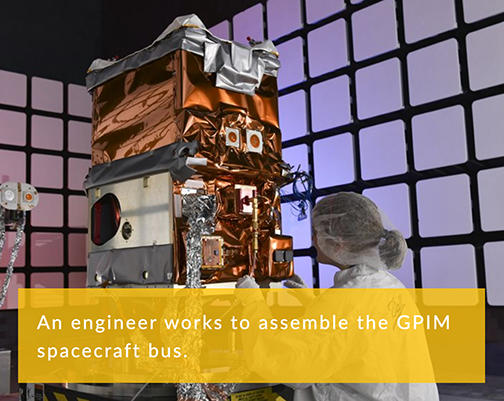

A Ball Aerospace satellite used for NASA's Green Propellant Infusion Mission (GPIM) is ready for launch, scheduled for no earlier than June 24 on board a SpaceX Falcon Heavy rocket.
Ball built the smallsat, which contains NASA's first opportunity to demonstrate a new "green" propellant and propulsion system in orbit – an alternative to conventional chemical propulsion systems.

Image is courtesy of Ball Aerospace.
As the prime contractor for GPIM, Ball Aerospace is responsible for system engineering; flight thruster performance verification; ground and flight data review; spacecraft bus; assembly, integration and test; and launch and flight support. The spacecraft bus is the smallest of the Ball Configurable Platform (BCP) satellites, which is about the size of a mini refrigerator, and was assembled in just 46 days.
The BCP provides standard payload interfaces and streamlined procedures, allowing rapid and affordable access to space with flight-proven performance. There are currently two BCP small satellites performing on orbit: STPSat-2, which launched in November 2010, and STPSat-3, which launched in November 2013. The two STP satellites were built for the U.S. Air Force Space Test Program's Standard Interface Vehicle (STP-SIV) project.

Artistic rendition of the GPIM spacecraft.
Image is courtesy of Ball Aerospace.
GPIM is part of NASA's Technology Demonstration Missions program within the Space Technology Mission Directorate (STMD), and Christopher McLean of Ball Aerospace serves as the principal investigator. The mission will demonstrate the practical capabilities of AF-M315E, a Hydroxyl Ammonium Nitrate fuel and oxidizer monopropellant developed by the Air Force Research Laboratory.
In addition to STMD and Ball Aerospace, the GPIM team includes: Aerojet Rocketdyne; U.S. Air Force Research Laboratory at Edwards Air Force Base; the Air Force Space and Missile Systems Center at Kirtland Air Force Base, New Mexico; and three NASA field centers — NASA's Glenn Research Center in Ohio, NASA's Kennedy Space Center in Florida, and NASA's Goddard Space Flight Center in Maryland.
GPIM is one of several payloads launching as part of the Department of Defense STP-2 mission managed by the U.S. Air Force Space and Missile Systems Center. Another payload, the Constellation Observing System for Meteorology, Ionosphere, and Climate-2 (COSMIC-2) satellite, carries five Ion Velocity Meters built by Ball and designed by the University of Texas at Dallas (UTD) that will measure one parameter of the space weather environment as part of a successful technology transfer program. COSMIC-2 is a joint mission including the National Oceanic and Atmospheric Administration, U.S. Air Force, Taiwan's National Space Organization and the University Corporation for Atmospheric Research.
Dr. Makenzie Lystrup, VP and GM, Civil Space, Ball Aerospace, said that GPIM has the potential to inspire new ideas and new missions, which could mean smaller spacecraft, faster and easier ground processing, longer design lives and more. Ball is also developing small satellites for two other NASA missions — the Imaging X-Ray Polarimetry Explorer (IXPE) and the Spectro Photometer for the History of the Universe, Epoch of Reionization and Ices Explorer (SPHEREx) missions.

